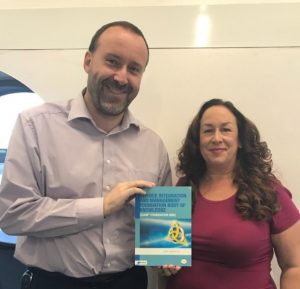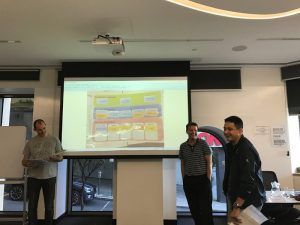In this blog, you’ll find a review of the SIAM Foundation course from a training pioneer. Thanks for Michelle and Simon from Kinetic IT for sharing their feedback.
Our SIAM journey so far…
Simon Dorst and Michelle Major-Goldsmith of Kinetic IT are members of the SIAM® Foundation Body of Knowledge (BoK) Architect group. Having recently run their first ever SIAM Foundation course in Perth, Western Australia they agreed to share their experiences of being involved in the BoK developments and the SIAM Foundation certification and how that translated into the classroom. Download the SIAM Foundation Body of Knowledge for free here.
About Kinetic IT
Kinetic IT is a leading Australian-owned enterprise class Managed Services provider, with over 1,300 experienced staff and offices in most major Australian capital cities. Since 1995, Kinetic IT has been delivering quality services to large and complex ICT environments across corporate, resources, government and utilities sectors, resulting in managed and sustained growth with exceptional customer satisfaction ratings.
Kinetic IT is a recognised leader in the provision of innovative and practical service management solutions having developed relevant and targeted solutions for some of the largest and most complex environments in Australia.
Commitment to Service Management
Kinetic IT’s position as one of Australia’s early adopters of ITIL® and its commitment to service management has been a key contributor to its success. Kinetic IT is an Accredited Training Organisation (ATO) for SIAM and ITIL®, as well as an AXELOS Consulting Partner (ACP) for ITIL and P3M3®. Kinetic IT invests in the competency of its staff in complimentary frameworks, such as DevOps, Lean, PRINCE2®, COBIT® and ISO/IEC 20000. It employs staff certified in these (and others) qualifications and shares practices and experiences across the organisation, customers and community.
Service Integration and Management (SIAM)
SIAM is an approach for managing complex, multi-sourced environments. SIAM has a different level of focus to traditional multi-sourced ecosystems with management, integration, assurance, and coordination to ensure that the customer organisation gets maximum value from its service providers. These are the real-world environments of Kinetic IT’s customers and the key to success is the ability to manage the challenge of cross-functional, cross-process, cross-provider integration.
Whilst SIAM itself may not be new, what is new (or emerging) is the recognition that SIAM is essential to support the delivery of value in multi-supplier ecosystems. As more and more organisations move to this way of delivering services, the need for a standardised methodology became apparent. In 2015 Simon and Michelle published a white paper entitled ‘The King of SIAM’, in conjunction with AXELOS. Shortly after, the SIAM Foundation Architect Group was formed, with the objective to create a consolidated view of their knowledge and experience, to ensure the BoK met the real needs of practitioners world-wide.
Foundation BoK development
Simon and Michelle were delighted to be invited by Claire Agutter from Scopism to join the SIAM Foundation Architect group. The vision for the body of knowledge (BoK) was to create a document that was practitioner-led and supported real world experience. The Foundation BoK contains content to support the new SIAM Foundation training course available via EXIN and BCS, and is based on the input from a variety of organisations and industry professionals.

This new certification is the first one to be developed on the topic of SIAM, a concept, which although not new, has seen a growth in adoption following the trend towards multi-sourcing and distributed services. The course fills a gap in the current ICT certification landscape and provides an ideal opportunity for delegates to expand their knowledge in service integration and management. SIAM is tailored to a multi-party environment and focuses on the specific challenges that come with multi-sourcing and adapts existing service management processes, practices and techniques to work effectively in a multi-service provider environment.
Pilot – SIAM Foundation Course
In early April, Michelle and Simon co-delivered a three-day pilot course (the first in Australia) which involved 2 days of syllabus driven lectures, discussions and class exercises followed by an examination and a day of gamification.
The delegates were all experienced SIAM practitioners, invited specifically to critique and provide feedback regarding the relevance of both the content and make-up of the course as well as the qualification within the industry. The course covered areas such as the SIAM roadmap for implementation and the governance, management and operating models, and the integrated process approach of SIAM (and the ability to use your service management model and tools of choice, be that COBIT, Agile ITIL or others).
The course was run as more of a workshop with full contribution, extensive discussion and some fantastic real world experience and anecdotes to enliven the course formality and make for a fun learning experience for all involved. After the exam on the morning of day 3, the delegates could relax and move into an afternoon of gamification that included boards games, quizzes and role play to help them truly consolidate their experiences.
Course Feedback
As the course concluded we ran an open forum to encourage delegates to provide full feedback on the BoK content, the course format and their experience of the session. Some of the feedback we found particularly useful was:
- There is a lot of theory in the Body of Knowledge. This is all quality information but due to the volume, pre-course reading of the BoK and process guides is essential to get the most out of understanding and applying (rather than learning) the concepts
- Participants have different preconceived ideas of what SIAM is. Doing the course solidified the main principles and clarified the distinction between SIAM® and ITIL® (this is of course the exact reason why the BoK and accreditation were created)
- As the course doesn’t focus much on service management processes (but rather how important it was to control inputs and outputs), operational service management knowledge is important and so previous IT Service Management training (like ITIL®) is beneficial and again expedites the learning, allowing more focus on practical application
- The course and content benefited from the hands-on, practical and gamified exercises. Days one and two allowed the core BoK content, principles, suggested SIAM layers, structural elements, implementation roadmap and challenges and risks to be explored. Day three was an opportunity to apply the learning from the previous days. Being able to have robust discussions about the benefits and weakness of each SIAM model and the very real challenges associated with creating an ecosystem, modifying behaviours and the approaches that must be considered to get providers to work successfully together (some of whom which might be competing commercially) was useful
Simon and Michelle both felt that the course validated many of the choices made by the architect team for the BoK, in terms of core concepts and definitions chosen, but also in the generic nature of the content that makes it applicable in any organisation. With plans to develop SIAM Professional gradually unfolding this Foundation BoK and training has provided us with solid basis to develop more of the ‘how to’ implement a SIAM ecosystem.
As well as the feedback we received to help us to shape future courses, the whole group – delegates and trainers – said they enjoyed the whole experience, learnt a great deal and of course were delighted to be amongst the first people in the world to have a SIAM® Foundation Certificate with 100% pass success on this course!
Some feedback:
- ‘My understanding of SIAM increased greatly because of this course
- ‘SIAM is not only about ITIL® … it is a blend & integration of various practices’
Below are some pictures from the course with the teams first creating and then presenting a (simplified, gamified) SIAM model.


Why should you attend the SIAM® Foundation course?
The course has relevance for anyone who has an interest in the practices of SIAM. Furthermore, it also targets practitioners that want to implement the SIAM methodology in an organisation, particularly those professionals who are already working with IT service management processes.
The SIAM course is appropriate for many IT management roles, including:
- Change Managers, Service Level Managers, Business
- Relationship Managers, Supplier Managers
- Chief Strategy, Information and Technical Officers
- Business and Organisational Change Practitioners
- Service Managers
- Service Provider Portfolio Strategists
- Process Managers
- Project & Program Managers
- Service and Process Architects
The course covers topics such as:
- SIAM Fundamentals
- Implementation Roadmap
- Roles and Responsibilities
- Practices
- Processes to support SIAM
- SIAM Challenges and Risks
- SIAM and other practices
For more information about the opportunities to attend a course, find a training provider on the EXIN and BCS websites. You can also contact Kinetic IT by email at training@kineticit.com.au.



